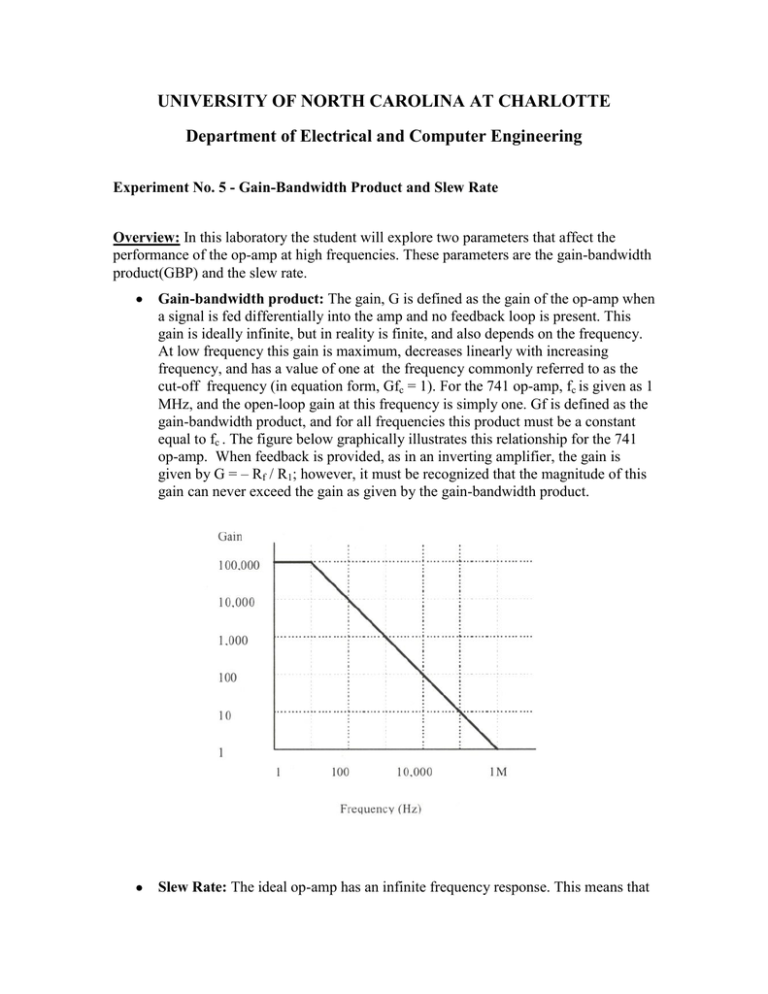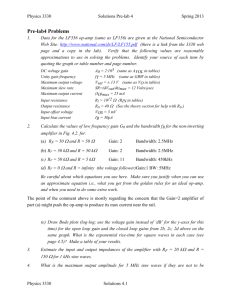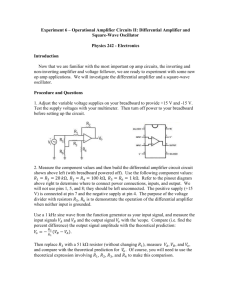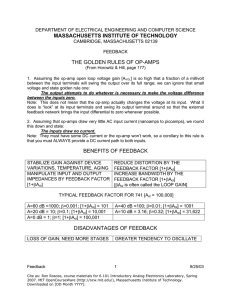Gain-Bandwidth Product and Slew Rate
advertisement

UNIVERSITY OF NORTH CAROLINA AT CHARLOTTE Department of Electrical and Computer Engineering Experiment No. 5 - Gain-Bandwidth Product and Slew Rate Overview: In this laboratory the student will explore two parameters that affect the performance of the op-amp at high frequencies. These parameters are the gain-bandwidth product(GBP) and the slew rate. Gain-bandwidth product: The gain, G is defined as the gain of the op-amp when a signal is fed differentially into the amp and no feedback loop is present. This gain is ideally infinite, but in reality is finite, and also depends on the frequency. At low frequency this gain is maximum, decreases linearly with increasing frequency, and has a value of one at the frequency commonly referred to as the cut-off frequency (in equation form, Gfc = 1). For the 741 op-amp, fc is given as 1 MHz, and the open-loop gain at this frequency is simply one. Gf is defined as the gain-bandwidth product, and for all frequencies this product must be a constant equal to fc . The figure below graphically illustrates this relationship for the 741 op-amp. When feedback is provided, as in an inverting amplifier, the gain is given by G = – Rf / R1; however, it must be recognized that the magnitude of this gain can never exceed the gain as given by the gain-bandwidth product. Slew Rate: The ideal op-amp has an infinite frequency response. This means that no matter how fast the input changes, the output will be able to keep up. In real op-amps, this is not the case, and when the input changes too fast the output is not able to keep up. The specification known as slew rate defines the maximum rate at which the output voltage can change with time. It is generally given in V/μs., and for the 741 op-amp is something close to 1v/μs . When an ideal square wave (i.e., one with an infinitely sharp edge) is applied, as shown in the figure below, the slope of the output pulse provides a measurement of the slew rate. The frequency of the input square wave is increased until the slope of the output triangular waveform can be measured. It should be clear that measuring the slew rate of an op-amp with this method requires that the rate of change of voltage for the input square wave must be greater than the slew rate of the op-amp for which slew rate is being measured. While the frequency of operation is related to slew rate it must be recognized that both slew rate and output voltage range are required to determine the maximum frequency without distortion. How to determine the bandwidth of an amplifier experimentally: 1- Assume that we wish to determine the useful frequency range for a particular amplifier that has a gain, determined by the input and feedback resistors, R1 and Rf (this could be a standard inverting amplifier).We apply a sinusoidal input voltage from a function generator, being sure to keep the frequency low at first, below the expected upper breakpoint frequency, and the amplitude small enough to avoid slew-rate limiting of the output voltage. 2- Observe the output voltage, and adjust the generator amplitude so that the display is eight divisions on the screen of the oscilloscope when the vertical sensitivity is 100 mV/div. In the figure below, this is the sinusoid voltage with a single cycle displayed and an amplitude of eight divisions peak-topeak or simply 800 mVp-p . 2 3- At the breakpoint frequency, the amplitude of the output voltage will drop by 3 db to 0.707 of its pass band value. Using 8 divisions as the peak-to-peak pass band value, the output at the breakpoint frequency will be 0.707x 8 or 5.66 divisions. 4- Slowly increase the frequency until the amplitude drops to 5.66 divisions (566 mVp-p). The frequency has changed so that eight cycles of the sinusoid are now displayed (i.e., the frequency has been increased by a factor of eight). At this time we can measure the period and determine the breakpoint frequency (f = 1/ T). 5- Before concluding that this is the experimentally determined bandwidth, you must determine that the output voltage did not decrease in amplitude due to slew-rate limiting. This can be done by a combination of slew-rate calculations and repeated measurements at lower amplitudes. If you are experiencing slew-rate limiting in step 4, simply decreasing the amplitude of the generator will produce a different result. 3 Pre-Lab – Slew Rate Obtain and record the gain bandwidth product, slew rate, and pin connections for the LM741 Op-Amp and the LF356 Op-Amp from a manufacturer’s datasheet. (INSTRUCTOR’S SIGNATURE_____________________________DATE 4 ) Lab Session – Slew Rate 1. Construct a non-inverting amplifier with a gain of +2v/v using the 741op-amp. 2. With a 10 Vp-p sinusoidal input voltage, slowly raise the frequency from 10 Hz to 30 kHz. To be sure you can observe the shape of the output voltage as it changes with frequency, you will need to continually adjust the oscilloscope time base. Describe what happens to the output voltage waveform as the frequency increases. 3. Apply an appropriate (remember that slew rate affects large signals more than small signals) square wave input voltage. Measure the slew rate, by adjusting vertical and horizontal controls until you get a linear diagonal on the screen. Do this for positive and negative slopes. Record the image on a compact flash card. 4. Change the gain to +5v/v. Measure and record the slew rate and gain. 5. Compare the results in steps 3 and 4 with the published value of slew rate for the 741op-amp. 6. Construct an inverting amplifier with a gain of -0.5v/v. Make R1 = 1 kΩ (the negative input resistor), and choose the appropriate value for RF. 7. With Vin small enough to avoid slew-rate distortion, measure and record the bandwidth of the amplifier. Record this Vin and BW, and subsequent data, in a table. 8. Repeat step 7, for gains of -1, -10, -100, and -500 v/v. For each gain above, be sure that your op-amp was not slew-rate limiting at the frequency you determined to be the bandwidth. This can be corrected by reducing the magnitude of Vin and repeating the measurement. 9. Now connect the LF356 op-amp in the voltage follower configuration. Apply an appropriate (remember that slew rate affects large signal more than small signals) square wave input voltage. Measure the slew rate, by adjusting the vertical and horizontal controls until you get a linear diagonal on the screen. Do this for positive and negative slopes. If you encounter instabilities refer to Figure 1 of the LF356 data sheet to see a stabilized unity gain circuit suitable for measuring slew rate. 10. Observe the input square wave with the oscilloscope on an expanded time scale that will allow for the measurement of the function generator slew rate. Do this at a frequency of 1kHz with a 10Vp-p input. Record your results. 5 Lab Session – Slew Rate (Data Sheet) INSTRUCTOR'S INITIALS DATE: 6 Post Lab – Slew Rate 1. Construct a full-page graph of voltage gain magnitude vs. bandwidth using loglog paper or an Excel spreadsheet (log axes) for the gain values in steps 6, 7 and 8 for the LM741 op-amp. What shape does the curve have? What differences exist between this graph and the theoretical graph? 2. The gain bandwidth product is given by G(BW) = fc , where fc is the unity gain bandwidth or cutoff-frequency. Using the values from steps 6, 7, and 8, calculate the average value of fc and compare with the LM741 data sheet value. 3. How did the measured values of gain-bandwidth product and slew rate compare with the data-sheet values for the LM741 and LF356? Do you believe the slew rate values found for the LM741 and LF356 are correct? Why or why not? 7







